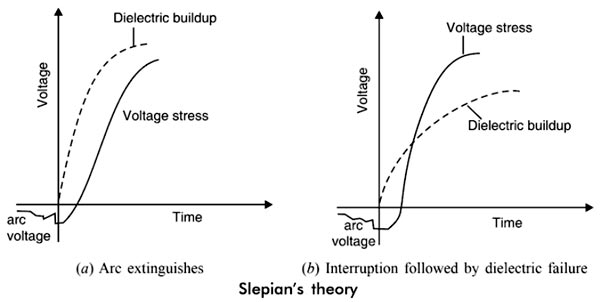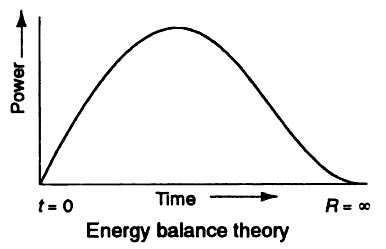Arc in a circuit breaker is interrupted at
Right Answer is:
Zero current
SOLUTION
After the occurrence of the fault, when the contacts of the CB begin to separate an arc is established in the contact gap.
The two main causes responsible for generating an arc between the contacts of a CB are as follows:
Potential difference (PD) between the contacts: When the contacts have a small separation, the PD between them is sufficient to maintain the arc. One way to extinguish the arc is to separate the contacts to such a distance that PD becomes inadequate to maintain the arc. However, this method is impracticable in a high voltage system where the separation of many meters may be required.
Ionized particles between contacts: The ionized particles between the contacts tend to maintain the arc. If the arc path is deionized, the arc extinction will be facilitated. This may be achieved by cooling the arc or by bodily removing the ionized particles from the space between the contacts.
Methods of Arc Extinction
There are two methods of extinguishing the arc in CB viz.
- High Resistance Method
- Low resistance Method
In this method, arc resistance is made to increase with time so that current is reduced to a value insufficient to maintain the arc. Consequently, the current is interrupted or the arc is extinguished. The principal disadvantage of this method is that enormous energy is dissipated in the arc. Therefore, it is employed only in DC CBS and low-capacity AC CBs.
The resistance of the arc may be increased by:
- Increasing the Length: The resistance of the arc is directly proportional to its length. The length of the arc can be increased by increasing the gap between contacts.
- Cooling of Arc:– Cooling helps in the deionization of the medium between the contacts. This increases the arc Resistance. Efficient cooling Slav, be obtained by a gas blast directed along the arc.
- Reducing the cross-section area of an arc:- If the area of the cross-section of the arc is reduced, the voltage necessary to maintain the arc is increased. In other words, the resistance of the arc path is increased. The cross-section of the arc can be reduced by letting the arc pass through a narrow opening or by having a smaller area of contact.
- Splitting of arc:- The resistance of the arc can be increased by splitting the arc into a number of smaller arcs in the series. Each one of these arcs experiences the effect of lengthening and cooling. The arc may be split by introducing some conducting plates between the contacts.
Low Resistance or Current Zero Method
This method is employed for arc extinction in AC circuits only. In this method, arc resistance is kept low until the current is zero where the arc extinguishes naturally and is prevented from restriking in spite of the rising voltage across the contacts. All modern high-power AC CB employ this method for arc extinction.
In an AC system, the current drops to zero after every half cycle. At every current zero, the arc extinguishes for a brief moment. Now the medium between the contacts contains ions and electrons so that it has a small dielectric strength and can be easily broken down by the rising contact voltage known as restriking voltage. If such a breakdown does occur, the arc will persist for another half cycle. If immediately after current zero, the dielectric strength of the medium between contacts is built up more rapidly than the voltage across the contacts, the arc fails to restrike and the current will be interrupted. There are two theories to explain the zero current interruption of the arc.
- Recovery rate theory (Slepian’s Theory)
- Energy balance theory (Cassie’s Theory)
Recovery rate theory
The arc is a column of ionized gases. To extinguish the arc, the electrons and ions are to be removed from the gap immediately after the current reaches a natural zero. ions and electrons can be removed either by recombining them into neutral molecules or by sweeping them away by inserting insulation medium (gas or liquid) into the gap. The arc is interrupted if ions are removed from the gap at a rate faster than the rate of ionization. In this method, the rate at which the gap recovers its dielectric strength is compared with the rate at which the restriking voltage (Transient voltage) across the gap rises. If the dielectric strength increases more rapidly than the restriking voltage, the arc is extinguished. If the restriking voltage rises more rapidly than the dielectric strength, the ionization persists and breakdown of the gap occurs, resulting in an arc for another half cycle.

Energy balance theory
The space between the contact contains some ionized gas immediately after current zero and hence, it has a finite post-zero resistance. At the current zero moments, power is zero because the restriking voltage is zero. When the arc is finally extinguished, the power again becomes zero, the gap is fully deionized and its resistance is infinitely high In between these two limits, first, the power increase reaches a maximum value, then decreases and finally reaches zero value. Due to the rise of restriking voltage and associated current energy is generated in the space between the contacts. The energy appears is in the form of heat. The circuit breaker is designed to remove this generated her as early as possible by cooling the gap, giving a blast of air or flow of oil at high velocity and pressure. If the rate of removal of heat is faster than the rate of heat generation the arc is extinguished if the rate of heat generation is more than the rate of heat dissipation, space breaks down again resulting in an arc for another half cycle.

